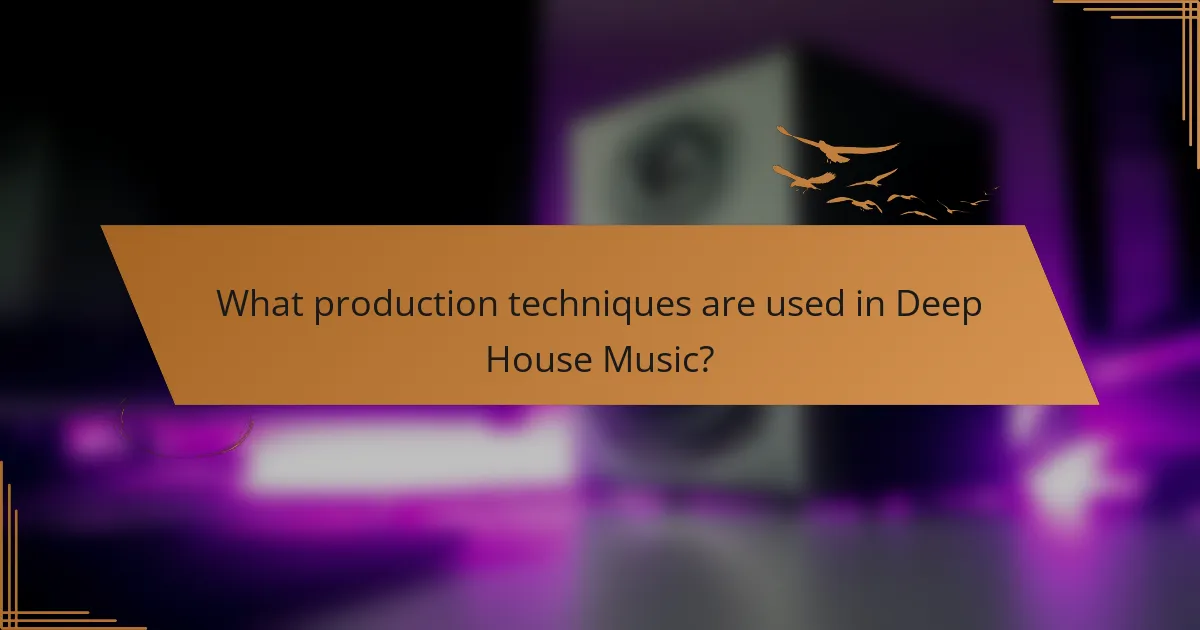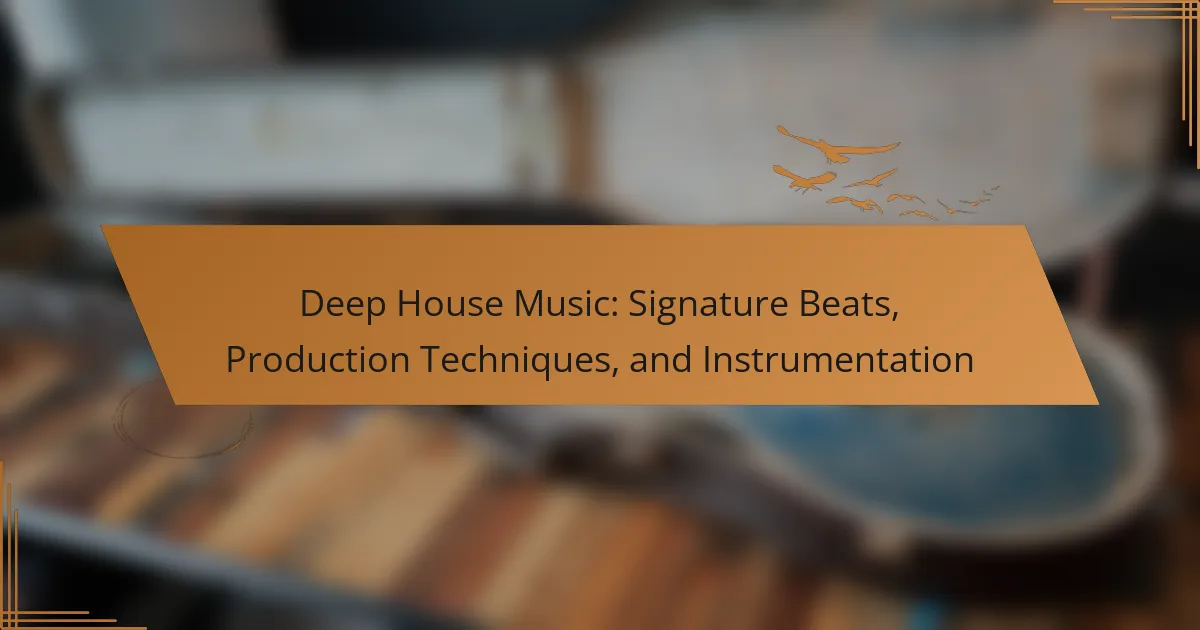Deep house music is a subgenre of house music known for its complex melodies, soulful vocals, and slower tempo, typically between 120 to 125 beats per minute. This genre blends elements of jazz, funk, and soul, creating a rich and atmospheric sound that emerged in the 1980s, influenced by artists like Larry Heard and Frankie Knuckles. Key characteristics of deep house include a steady four-on-the-floor kick drum pattern, deep basslines, and smooth chord progressions, enhanced by the use of synthesizers and electronic instruments. The production techniques involve sampling, layering, and applying effects such as reverb and delay, contributing to the genre’s distinctive sound and ongoing evolution in clubs and festivals worldwide.

What is Deep House Music?
Deep house music is a subgenre of house music characterized by its complex melodies and soulful vocals. It typically features a slower tempo, often ranging from 120 to 125 beats per minute. Deep house incorporates elements from jazz, funk, and soul, creating a rich and atmospheric sound. The genre emerged in the 1980s, with influential artists like Larry Heard and Frankie Knuckles shaping its style. Deep house tracks often utilize deep basslines and smooth chord progressions. The use of synthesizers and electronic instruments is prevalent in the production of deep house music. This genre has gained popularity in clubs and festivals worldwide, appealing to a diverse audience. Its unique sound continues to evolve, influencing new artists and genres.
How did Deep House Music originate?
Deep House Music originated in the 1980s as a subgenre of house music. It emerged primarily in Chicago and was influenced by jazz, soul, and funk. Pioneers like Larry Heard and Frankie Knuckles played significant roles in its development. Deep house is characterized by its smooth, complex melodies and deep basslines. The genre integrates elements of ambient music, creating a relaxed vibe. By the late 1980s, deep house began to gain popularity in clubs and radio stations. Its distinct sound set it apart from other house music styles. Today, deep house continues to evolve while retaining its foundational elements.
What are the historical influences on Deep House Music?
Deep House Music is influenced by various historical genres and cultural movements. It emerged in the 1980s, rooted in Chicago house music. Early pioneers like Frankie Knuckles and Larry Heard shaped its sound. The genre incorporates elements from soul, jazz, and funk. These influences contribute to its melodic and harmonic richness. Additionally, the use of synthesizers and drum machines became prominent during this time. The fusion of these styles created a unique atmosphere in Deep House tracks. This blend continues to resonate in contemporary productions.
Who are the key pioneers of Deep House Music?
The key pioneers of Deep House Music include Larry Heard, Frankie Knuckles, and David Morales. Larry Heard, also known as Mr. Fingers, is credited with creating the genre’s signature sound in the 1980s. His track “Can You Feel It” is a seminal deep house classic. Frankie Knuckles, known as the “Godfather of House,” played a crucial role in popularizing deep house in Chicago. His remixes and productions helped shape the genre’s identity. David Morales is another influential figure, known for his innovative mixing and production techniques. His work in the late 1980s and early 1990s further established deep house on the global stage. These artists contributed foundational tracks and styles that define deep house music today.
What are the defining characteristics of Deep House Music?
Deep House Music is characterized by its smooth, soulful sound and deep basslines. It typically features slower tempos, often ranging from 120 to 125 BPM. The genre incorporates elements of jazz, funk, and soul, creating a rich auditory experience. Vocals in Deep House are often soft and melodic, enhancing its emotional depth. The use of lush chords and atmospheric pads contributes to its immersive quality. Deep House often employs a four-on-the-floor beat structure, providing a consistent rhythmic foundation. The production techniques include extensive use of reverb and delay, adding space and texture to the sound. Overall, Deep House Music creates a laid-back yet engaging atmosphere, suitable for both listening and dancing.
How do tempo and rhythm shape Deep House Music?
Tempo and rhythm are fundamental elements that shape Deep House Music. Deep House typically features a tempo range of 120 to 125 beats per minute. This moderate tempo creates a laid-back yet danceable groove. The rhythm in Deep House often includes syncopated basslines and smooth, flowing beats. These rhythmic patterns contribute to a hypnotic feel, encouraging listener engagement.
The use of four-on-the-floor kick drums establishes a steady pulse. This consistency allows for intricate layering of percussive elements. Additionally, Deep House often incorporates swing and shuffle rhythms, adding complexity to the groove. The interplay of these rhythmic components creates a rich sonic texture. Overall, tempo and rhythm are essential in defining the unique sound and emotional impact of Deep House Music.
What role do vocals play in Deep House Music?
Vocals in Deep House Music serve to enhance emotional depth and connection. They often feature soulful melodies and harmonies. These vocals can convey themes of love, introspection, and life experiences. Their presence adds a human element to the electronic soundscape. Vocals may be sampled or performed live, contributing to the genre’s unique texture. The use of vocal chops is also common, creating rhythmic patterns that complement the beats. Overall, vocals are crucial for establishing atmosphere and engaging listeners in Deep House tracks.

What are the signature beats of Deep House Music?
Deep House Music features a signature beat characterized by a steady four-on-the-floor kick drum pattern. This pattern typically operates at a tempo range of 120 to 125 beats per minute. The kick drum is often accompanied by a deep bassline that provides groove and rhythm. Hi-hats and claps are strategically placed to create syncopation and add texture.
The use of soulful vocal samples is common, enhancing the emotive quality of the music. Chord progressions often utilize jazzy or soulful elements, contributing to the genre’s distinct sound. Additionally, atmospheric pads and synths are layered to create depth.
These elements combine to produce a smooth, laid-back vibe that defines Deep House. This genre emerged in the 1980s, influenced by Chicago house music and jazz. Its signature beats have remained consistent, making it a recognizable style within electronic music.
How do the beats differ from other genres?
Beats in deep house music differ from other genres primarily through their rhythmic complexity and laid-back feel. Deep house typically features a slower tempo, usually between 120 to 125 BPM. This tempo creates a relaxed atmosphere that distinguishes it from more upbeat genres like techno or house. The beats often incorporate syncopated kick drums and soft hi-hats, adding depth and groove.
Additionally, deep house employs intricate basslines that are melodic and deep, enhancing the overall vibe. The use of atmospheric pads and vocal samples further sets deep house apart, adding emotional layers to the tracks. These elements collectively create a unique sound that emphasizes mood and texture, unlike the more straightforward beats found in genres like pop or trance.
What is the typical drum pattern in Deep House Music?
The typical drum pattern in Deep House Music features a four-on-the-floor kick drum. This means the kick hits on every beat in a 4/4 time signature. The snare or clap usually falls on the second and fourth beats. Hi-hats often play a syncopated rhythm, commonly using closed hi-hats on the off-beats. Open hi-hats may also be introduced for added texture. The use of percussion elements can vary but often includes shakers or congas. This drum pattern creates a steady and danceable groove. The combination of these elements establishes the signature sound of Deep House Music.
How does the use of basslines enhance the sound?
Basslines enhance the sound by providing depth and rhythm in music. They create a foundation for harmony and melody. This foundation allows other instruments to layer effectively. In deep house music, basslines often drive the groove. They engage listeners by adding energy and movement. Studies show that bass frequencies resonate with the human body. This resonance can evoke emotional responses. A well-crafted bassline can elevate the overall listening experience significantly.
What are the common variations in Deep House beats?
Common variations in Deep House beats include the use of different tempos, rhythmic patterns, and instrumentation. Typical tempos range from 120 to 125 BPM, providing a laid-back groove. Rhythmic patterns often feature syncopated hi-hats and off-beat kicks. Instrumentation can vary, incorporating elements like smooth basslines, lush synths, and vocal samples. Some tracks may emphasize jazz or soul influences, while others lean towards minimalism. Each variation contributes to the distinctive sound of Deep House, appealing to diverse audiences.
How do different sub-genres influence beat structure?
Different sub-genres influence beat structure by dictating tempo, rhythm patterns, and instrumentation. For instance, deep house typically features a slower tempo around 120-125 BPM, emphasizing a laid-back groove. In contrast, tech house often incorporates a faster tempo, ranging from 125-130 BPM, leading to more driving beats.
Sub-genres like progressive house utilize layered beats and evolving rhythms, creating a more complex structure. Meanwhile, minimal house focuses on simplicity, often using sparse beats and fewer elements. Each sub-genre’s unique characteristics shape how beats are arranged and perceived in the music.
For example, the use of syncopation is more prevalent in funk-infused house, while a steady four-on-the-floor beat is common in many house tracks. These distinctions illustrate how sub-genres can significantly alter the overall feel and energy of a track.
What are the unique elements found in specific tracks?
Unique elements in specific deep house tracks include distinctive basslines, atmospheric pads, and vocal samples. Each track often features a unique combination of these elements. For example, a track may have a prominent sub-bass that drives the rhythm. Atmospheric pads create a lush soundscape, enhancing the emotional depth. Vocal samples can be manipulated for texture, adding a human element. Additionally, unique drum patterns and syncopation contribute to the groove. These elements combine to define the character of deep house music. Specific tracks may also incorporate unique instrumentation, such as live instruments or unconventional sound samples, setting them apart.

What production techniques are used in Deep House Music?
Deep House Music production techniques include sampling, layering, and using soft synths. Sampling involves incorporating snippets from various sources to create unique sounds. Layering enhances the depth of tracks by combining multiple audio elements. Soft synths, such as Serum and Massive, are widely used for creating rich textures. Additionally, sidechain compression is employed to achieve a pumping effect in the mix. Reverb and delay are often applied to create space and atmosphere. The use of 808 bass lines is a hallmark of the genre, providing a deep and resonant low end. These techniques collectively contribute to the signature sound of Deep House Music.
How does layering contribute to the overall sound?
Layering enhances the overall sound by adding depth and richness to the music. It involves combining multiple audio tracks to create a fuller sonic experience. Each layer can introduce different frequencies and textures. This technique allows for a more complex sound that engages listeners. In deep house music, layering often includes synths, basslines, and vocal elements. The interplay between these layers creates a dynamic auditory landscape. Research shows that well-layered tracks can evoke stronger emotional responses in listeners. Consequently, effective layering is essential for achieving the signature sound of deep house music.
What types of sounds are typically layered in production?
In deep house music production, various types of sounds are typically layered. Common layers include basslines, pads, and vocal samples. Basslines provide the foundational groove and rhythm. Pads create atmospheric textures that enhance the emotional depth. Vocal samples add human elements and can evoke feelings. Drums and percussion are layered for rhythmic complexity. Synth leads often stand out with melodic hooks. Effects such as reverb and delay are used to create spatial depth. Each sound contributes to the overall richness of the track.
How do producers achieve depth in their mixes?
Producers achieve depth in their mixes through techniques such as layering sounds, using reverb, and panning instruments. Layering involves combining multiple sounds to create a fuller texture. Reverb adds a sense of space and distance, enhancing the perception of depth. Panning instruments across the stereo field creates a three-dimensional sound experience. Additionally, adjusting frequencies allows certain elements to stand out while others sit back in the mix. Using automation helps in dynamically changing levels and effects throughout a track. These techniques are essential in deep house music to create an immersive listening experience.
What role do effects and processing play in Deep House production?
Effects and processing are crucial in Deep House production. They shape the overall sound and atmosphere of the music. Common effects include reverb, delay, and modulation. These effects add depth and space to tracks. Processing techniques like EQ and compression enhance clarity and balance. Additionally, sidechain compression creates a pulsing rhythm that is characteristic of Deep House. The use of effects contributes to the genre’s smooth and immersive sound. This approach allows producers to create a unique auditory experience that resonates with listeners.
How are reverb and delay utilized in Deep House tracks?
Reverb and delay are essential effects in Deep House tracks. Reverb creates a sense of space and depth in the mix. It simulates the natural reflections of sound in a room. This effect enhances vocal and instrumental elements. Delay adds rhythmic complexity and texture. It creates echoes that can complement the groove. Both effects are often used to create atmosphere. They help to blend different sounds cohesively. The use of these effects is common in Deep House production.
What are some common mixing techniques specific to Deep House?
Common mixing techniques specific to Deep House include using sidechain compression, reverb, and EQ adjustments. Sidechain compression creates a pulsing effect by ducking the bass or kick drum when other elements play. This technique enhances the groove and maintains clarity in the mix.
Reverb is often applied to vocals and synths to create depth and space. It helps to blend elements and gives a lush, atmospheric feel typical of Deep House. EQ adjustments are crucial for carving out space in the mix. This involves cutting frequencies that clash and boosting those that enhance the overall sound.
Utilizing these techniques contributes to the signature sound of Deep House. The genre often features smooth transitions and layered sounds, which these mixing methods facilitate.
What instruments are typically used in Deep House Music?
Deep House Music typically uses synthesizers, drum machines, and bass guitars. Synthesizers create lush chords and melodic lines that define the genre’s sound. Drum machines provide the rhythmic backbone, often featuring deep kick drums and crisp hi-hats. Bass guitars add warmth and groove, enhancing the overall depth of the track. Additionally, sampled instruments and vocal snippets are commonly incorporated. These elements combine to create the smooth, soulful vibe characteristic of deep house.
How do synthesizers shape the sound of Deep House?
Synthesizers significantly shape the sound of Deep House by creating lush, atmospheric textures. They produce a wide range of sounds, including pads, basslines, and leads. Deep House relies heavily on warm, analog synth sounds. These sounds contribute to the genre’s smooth and immersive quality.
The use of modulation in synthesizers adds depth and movement to the music. This technique enhances the rhythmic elements characteristic of Deep House. Additionally, synthesizers can emulate acoustic instruments, further enriching the sound palette.
The integration of effects like reverb and delay on synth sounds creates spaciousness. This is crucial for achieving the laid-back vibe typical of Deep House tracks. Overall, synthesizers are essential tools that define the sonic identity of Deep House music.
What live instruments are often incorporated into Deep House tracks?
Deep House tracks often incorporate live instruments such as keyboards, guitars, and percussion. Keyboards provide melodic and harmonic elements, enhancing the track’s depth. Guitars, both electric and acoustic, add rhythmic and melodic textures. Percussion instruments, like congas and shakers, contribute to the groove and rhythm. The use of these instruments creates a more organic sound, distinguishing Deep House from purely electronic music. Research indicates that live instrument integration in electronic genres increases listener engagement and emotional connection.
What are some best practices for producing Deep House Music?
To produce Deep House Music effectively, focus on creating a smooth, melodic sound. Utilize rich, warm basslines to establish a solid foundation. Incorporate atmospheric pads and chords to enhance depth. Use swing and shuffle in your drum patterns for a groovy feel. Employ vocal samples to add emotion and texture. Experiment with reverb and delay effects for spatial dynamics. Keep the arrangement minimal yet engaging to maintain listener interest. Finally, mix and master carefully to ensure clarity and balance across frequencies.
Deep House Music is a subgenre of house music known for its complex melodies, soulful vocals, and slower tempo, typically ranging from 120 to 125 beats per minute. The genre emerged in the 1980s, influenced by jazz, funk, and soul, with key pioneers like Larry Heard and Frankie Knuckles shaping its sound. This article explores the defining characteristics of deep house, including its signature beats, production techniques, and instrumentation, while highlighting the role of elements such as basslines, synthesizers, and live instruments in creating its unique auditory experience. Additionally, it examines the historical influences and variations within deep house, providing a comprehensive overview of the genre’s evolution and current trends.
